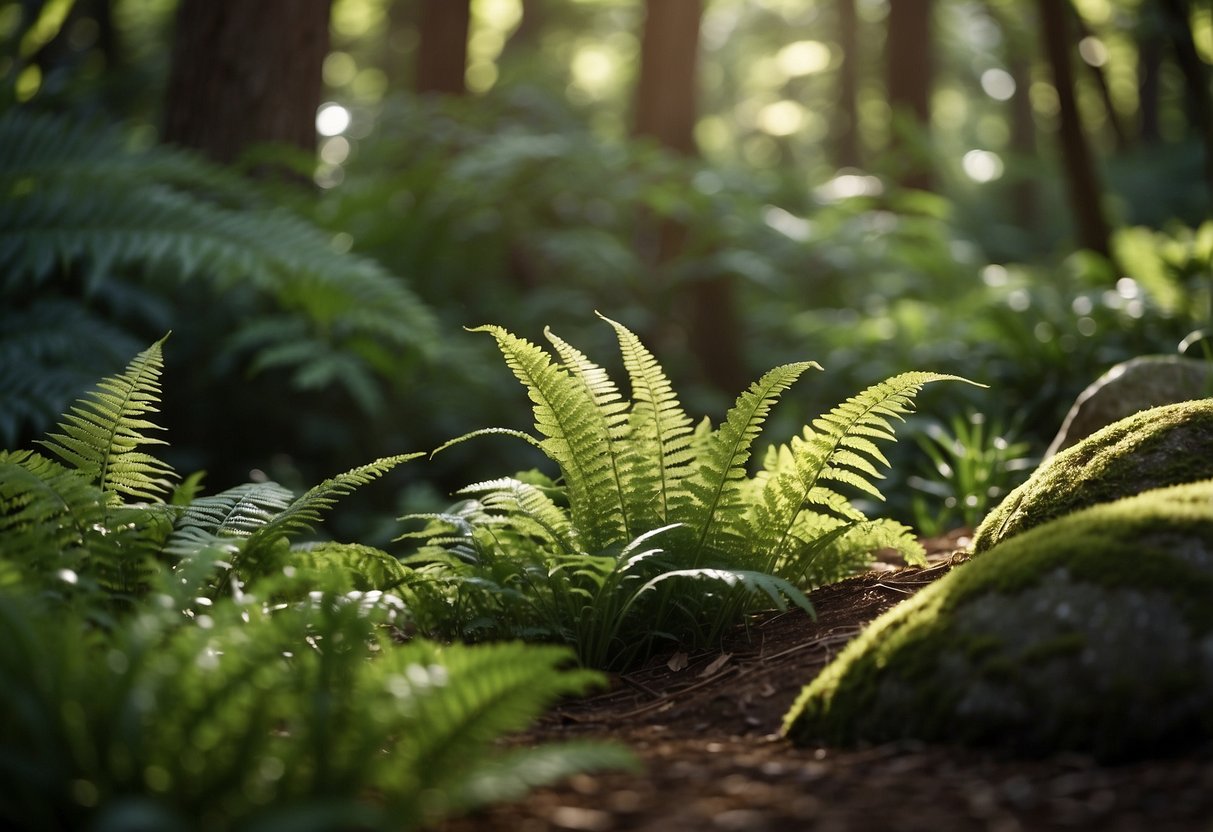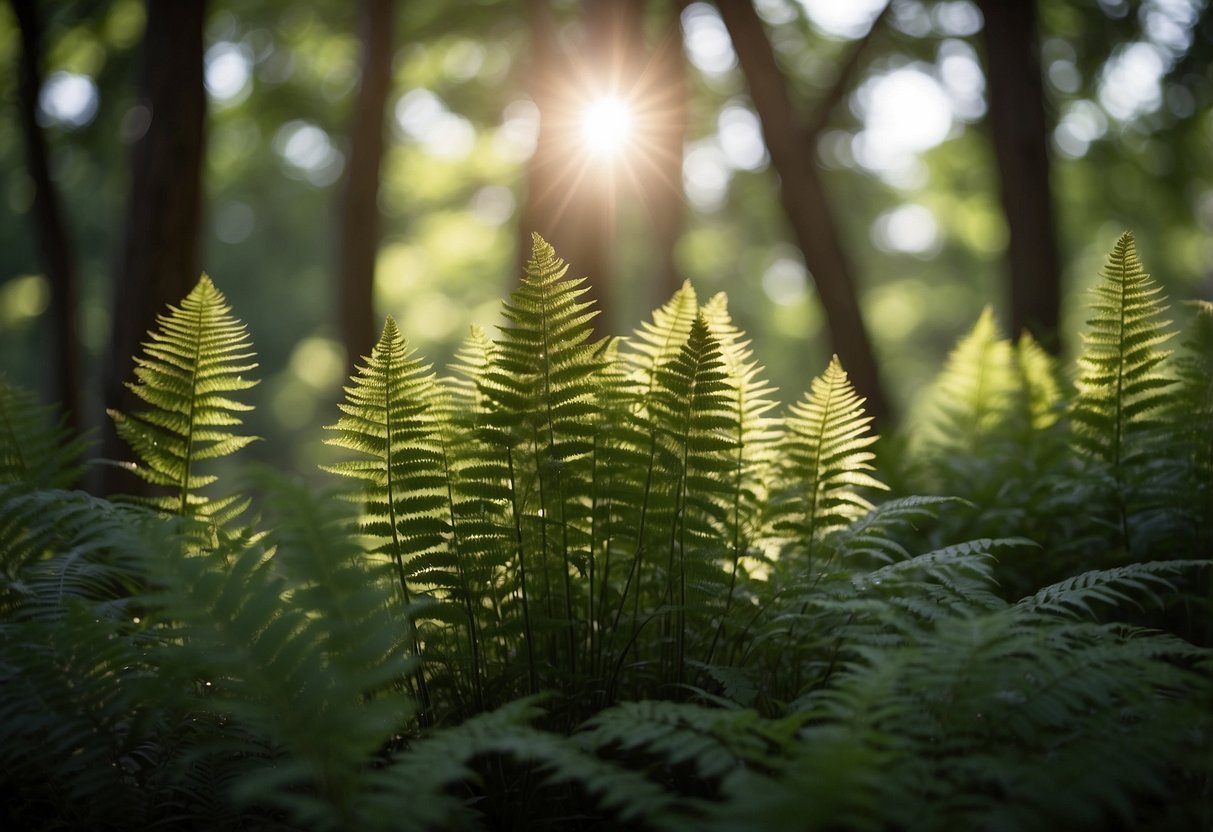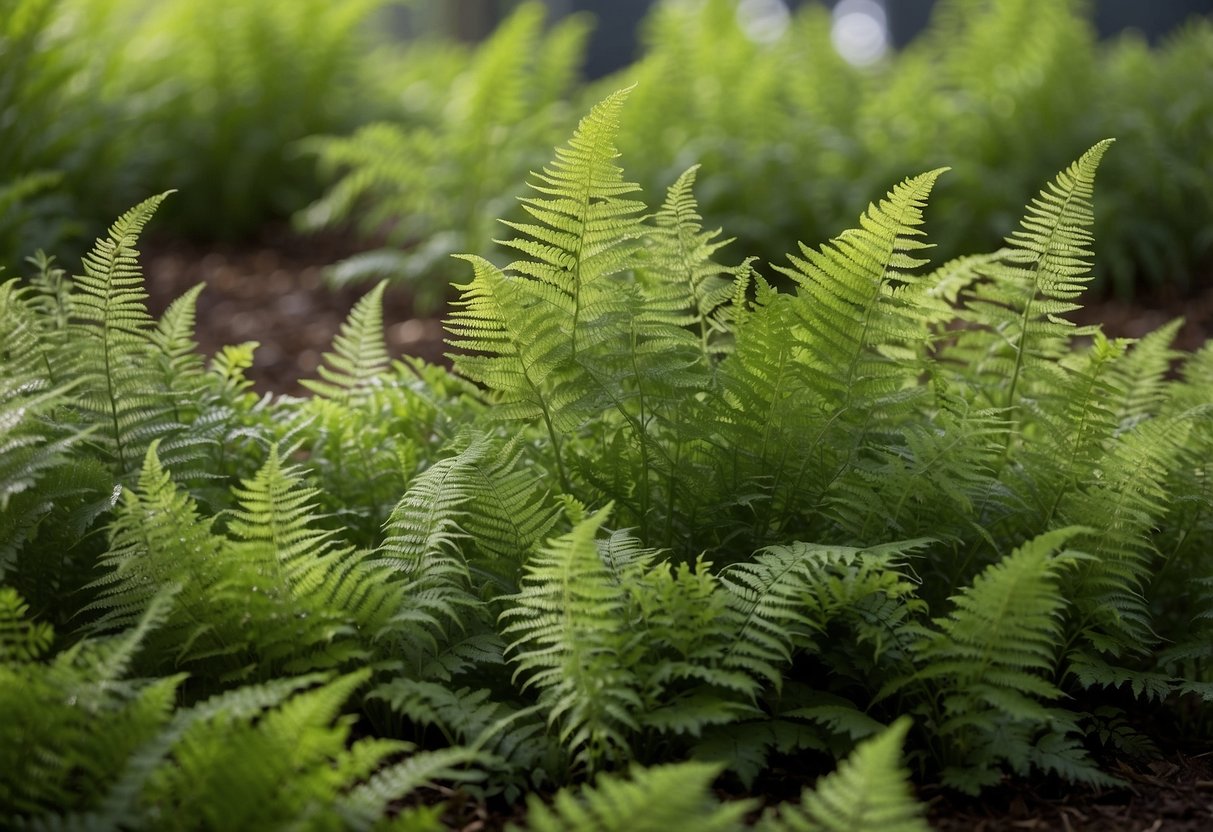Ostrich Fern Garden Ideas: Creative Ways to Grow and Enjoy This Lush Plant
If you’re looking to bring a lush, natural feel to your garden, ostrich ferns might be the perfect fit. These beautiful plants are known for their tall, feathery fronds that can create a serene, woodland ambiance right in your backyard. They thrive in shady, moist areas and can quickly transform an otherwise empty space into a green haven.

Incorporating ostrich ferns into your garden design can provide both aesthetic and functional benefits. They not only add visual interest with their unique texture but also help improve the overall soil quality and ecosystem of your garden. Whether you’re working with a small garden patch or a larger landscape, ostrich ferns can adapt and grow, offering versatility and beauty.
1) Create a shady corner with ostrich ferns

Transform a shady corner of your garden into a lush, green retreat with ostrich ferns. These ferns thrive in low-light conditions, making them perfect for areas under trees or next to buildings.
The large, feathery fronds of ostrich ferns create a tropical feel. Pair them with hostas or other shade-loving plants for added texture and color contrast. Be sure to keep the soil moist to keep your ferns happy.
For more ideas, check out these beautiful ostrich fern ideas to enhance your garden.
2) Ostrich Fern Border Pathway

You can create a stunning pathway by lining it with ostrich ferns. The ferns’ tall, feathery fronds add a lush, green touch that feels inviting.
To get started, dig a shallow trench along the edges of your path. Plant the ferns, keeping the crowns level with the soil to avoid rot.
Water the ferns immediately after planting. This helps settle the soil around the roots, ensuring your pathway stays vibrant and healthy. Keep the area well-maintained to enjoy your fern-lined path all year round.
3) Mix Ostrich Ferns with Hostas

Combining ostrich ferns with hostas can create a lush, shady retreat in your garden. Ostrich ferns are known for their tall, elegant fronds which contrast beautifully with the wide, textured leaves of hostas.
Place taller ostrich ferns at the back of your garden bed. Position hostas in front to create layers of height and texture.
Experiment with color. For example, plant a chartreuse-colored hosta near a dark green ostrich fern. This will add visual interest and variety to your garden space.
Learn more about creating vibrant combinations by visiting Epic Gardening and Raintree Gardens.
4) Use Ostrich Ferns Around a Pond

Ostrich ferns can create a beautiful, lush border around your pond. Their tall, feathery fronds can add a natural, graceful look.
They can grow up to 6 feet tall, providing great height and texture to your garden. Make sure to plant them in shady, moist areas for them to thrive.
These ferns also work well with other plants and can enhance the overall greenery around your pond.
5) Plant ostrich ferns in containers

You can grow ostrich ferns in containers if you’re short on space. Use a deep, wide pot to make room for their big roots. It’s important that your container has good drainage holes to stop water from puddling and causing the roots to rot.
Fill the pot with a mix of potting soil and compost. This gives your fern the nutrients it needs to grow strong. Place your container in a spot with low light. While ostrich ferns need regular watering, make sure the soil isn’t too soggy. Re-pot your fern into a larger container when it outgrows its current one.
6) Design a fern and moss garden

Start by choosing a shady spot in your garden. Ferns and moss thrive in low light and moist conditions.
Use a variety of ferns like the maidenhair fern and ostrich fern. Their varied textures and shapes will add visual interest.
Add patches of moss in between the ferns. Moss fills gaps and brings a soft, lush look to your garden. Water them regularly to keep the soil moist.
7) Ostrich ferns under large trees

Planting ostrich ferns under large trees is a great idea. These ferns thrive in shaded areas, making them perfect for spots under tree canopies.
Ostrich ferns like moist, well-draining soil. The shade from the trees helps keep the soil damp, which the ferns love.
Additionally, their feathery fronds add a lush, green touch to garden spaces beneath tall trees.
8) Create a Cool Retreat with Ferns and a Bench

Transform a corner of your garden into a refreshing oasis by placing a cozy bench among lush ostrich ferns.
Ferns have a calming effect and can create a serene atmosphere. They provide a rich, green backdrop that makes the space feel natural and peaceful.
A simple wooden bench will complement the ferns beautifully. Add cushions or blankets for extra comfort. Enjoy your quiet moments surrounded by nature’s beauty.
9) Mix ostrich ferns with spring bulbs

Combining ostrich ferns with spring bulbs can create a lush, dynamic garden. You can plant bulbs like daffodils or tulips alongside ostrich ferns.
The bulbs add bright, early color when the ferns are just starting to grow.
As the bulbs fade, the ferns fill in, maintaining your garden’s beauty through the summer.
10) Fern ground cover for shaded areas

Fern ground covers are perfect for shady spots in your garden. One popular choice is the ostrich fern. Its feathery plumes can grow up to six feet tall, providing lush, dramatic coverage.
Another great option is the soft shield fern. This medium green fern has a lace-like appearance and grows well in hardiness zones 6 through 8.
For coastal areas, consider the Western sword fern. Its shiny, deep green fronds reach up to four feet tall, creating a robust ground cover.
Benefits Of Growing Ostrich Ferns

Ostrich ferns can add both beauty and practical benefits to your garden. They stand out for their lush appearance and their edible fiddleheads.
Aesthetic Appeal
Ostrich ferns are known for their elegant, feathery fronds that closely resemble ostrich plumes. These vibrant green plants can grow up to six feet tall, making them an excellent choice for creating a dramatic backdrop. They thrive in moist, shady areas, providing a lush and tropical feel to your garden. Their ability to spread quickly through rhizomes makes them ideal for ground cover. This fern pairs well with hostas, astilbes, and other shade-loving plants, creating a rich tapestry of textures in your landscape.
Health Benefits
Ostrich ferns provide delicious fiddleheads, which are the young, coiled fronds before they unfurl. These fiddleheads are packed with nutrients, including fiber, omega-3 fatty acids, and vitamins A and C. You can harvest them in early spring and cook them similarly to asparagus or green beans. Some consume them for their potential anti-inflammatory properties. Incorporating fiddleheads into your diet adds variety and nutritional value, making ostrich ferns a beneficial plant for both gardeners and foragers.
Selecting The Perfect Location

Choosing the right spot for your ostrich fern garden is crucial for its success. Focus on soil quality and the amount of sunlight to provide the ideal environment for these plants.
Understanding Soil Requirements
Ostrich ferns thrive in moist and well-drained soil. The best soil for them is rich in organic matter and has a loamy texture. This ensures that the roots receive ample nutrients and water without becoming waterlogged.
Soil pH should be slightly acidic to neutral (around 6.0 to 7.0). Avoid planting ferns in dry, sandy, or heavy clay soils as they struggle to grow in such conditions. Mixing compost into the soil before planting can greatly improve the soil’s quality and structure.
Regularly check the soil moisture and avoid letting it dry out. Consistent moisture is key to maintaining lush green foliage, but be cautious of overwatering, which can lead to root rot.
Optimal Sunlight Conditions
Ostrich ferns prefer partial to full shade, replicating their natural woodland habitat. Too much direct sunlight can scorch their delicate fronds, causing browning and drying. Ideal locations include areas under trees or on the shaded sides of buildings.
If you want to plant them in slightly sunnier spots, ensure they receive no more than 2-3 hours of direct morning sunlight. Afternoon sun can be too intense. Providing some form of shade cover, like a garden umbrella or shade cloth, can also help manage light conditions.
Remember to observe the light patterns in your garden throughout the day. If the chosen spot offers too much sunlight, consider moving the ferns to a more shaded area to ensure their health and growth.
Care And Maintenance Tips

Taking care of ostrich ferns involves giving them the right amount of water and nutrients. They grow best in moist environments and benefit from regular watering and occasional fertilizing.
Watering Guidelines
Ostrich ferns thrive in moist soil. They prefer ground that is evenly damp but not waterlogged. If you let the soil dry out, the ferns’ foliage may turn brown and dry. It’s especially important to water them regularly during hot or dry periods.
Consider using a soaker hose to keep the soil moist without wetting the leaves too much. For indoor ferns, a humidifier helps maintain the right air moisture. If you don’t have one, misting the leaves with water every other day also works.
When planting ostrich ferns, make sure to water them immediately to settle the soil around the roots. Keep checking the moisture level and add water as necessary to ensure healthy growth.
Fertilizer Recommendations
Ostrich ferns grow well in rich, organic soil. Adding compost or well-rotted manure can enhance the soil’s nutrient content. You may use a balanced, slow-release fertilizer once in early spring to encourage growth.
An example of a good fertilizer might be one with equal parts nitrogen, phosphorus, and potassium (such as a 10-10-10 formula). Avoid over-fertilizing, as it can damage the roots and lead to poor growth.
For plants in pots, a diluted liquid fertilizer every few weeks during the growing season can provide additional nutrients. Make sure to follow the instructions on the fertilizer package for the best results. Regular feeding keeps your ostrich ferns lush and vibrant.







